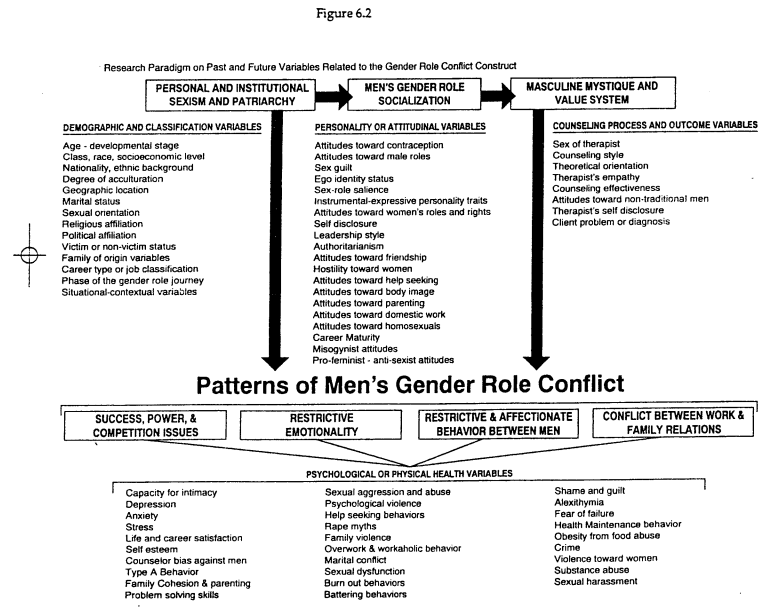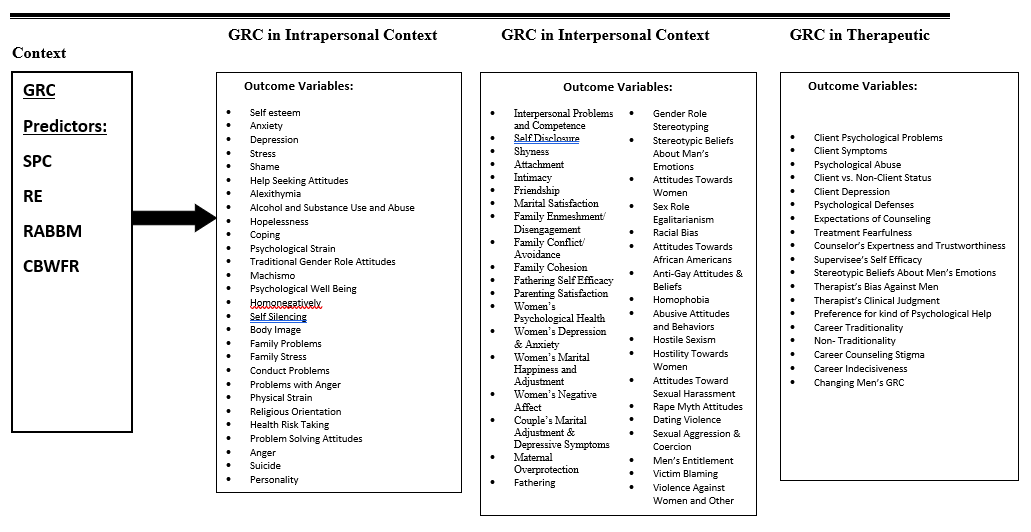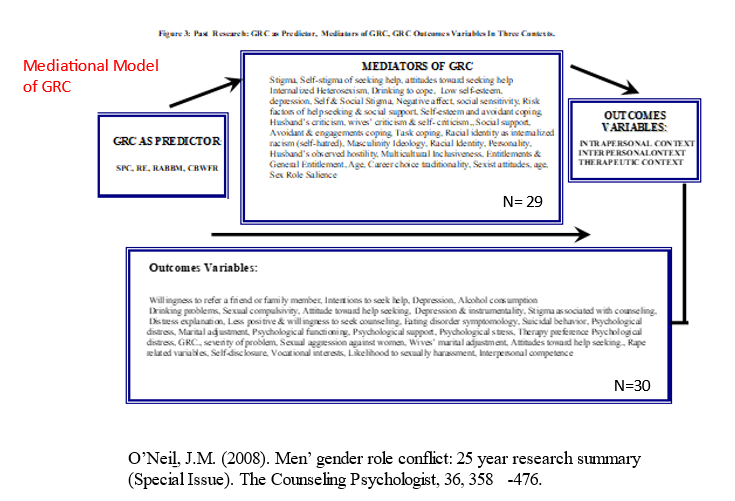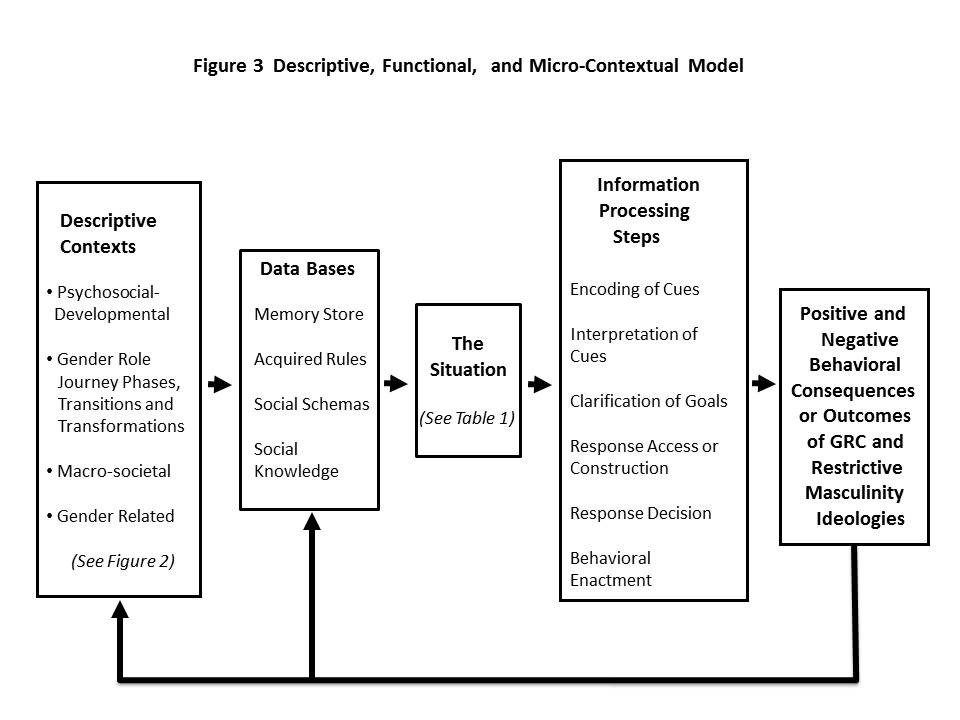- Introduction to Gender Role Conflict (GRC) Program
- Overall Information about GRC- Books, Summaries, & History
- Gender Role Conflict Theory, Models, and Contexts
- Recently Published GRC Studies & Dissertations
- Published Journal Studies on GRC
- Dissertations Completed on GRC
- Symposia & Research Studies Presented at APA 1980-2015
- International Published Studies & Dissertations on GRC
- Diversity, Intersectionality, & Multicultural Published Studies
- Psychometrics of the Gender Role Conflict Scale (GRCS)
- Factor Structure
- Confirmatory Factor Analyses
- Internal Consistency Reliability Data
- Internal Consistency & Reliability for 20 Diverse Samples
- Convergent & Divergent Validity of the GRCS Samples
- Normative Data on Diverse Men
- Classification of Dependent Variables & Constructs
- Authors, Samples & Measures with 200 GRC Guides
- Correlational, Moderators, and Mediator Variables Related to GRC
- GRC Research Hypotheses, Questions, and Contexts To be Explored
- Situational GRC Research Models
- 7 Research Questions/ Hypotheses on GRC & Empirical Evidence
- Important Cluster Categories of GRC Research References
- Research Models Assessing GRC and Hypotheses To Be Tested
- GRC Empirical Research Summary Publications
- Published Critiques of the GRCS & GRC Theory
- Clinically Focused Models, Journal Studies, Dissertations
- Psychoeducation Interventions with GRC
- Gender Role Journey Theory, Therapy, & Research
- Receiving Different Forms of the GRCS
- Receiving International Translations of the GRC
- Teaching the Psychology of Men Resource Webpage
- Video Lectures On The Gender Role Journey Curriculum & Additional Information
Research Models Assessing GRC and Hypotheses To Be Tested
Research models and hypotheses about GRC are briefly discussed in this file. The models can be useful in conceptualizing how moderator and mediator variables, including situational cues relate to GRC. These research models and hypotheses are evolving and promote more complex research designs, specifically how GRC develops psychosocially/developmentally and how it is acted out situationally in men’s lives. More elaborate research models are needed to assess GRC and the present ones are considered preliminary and incomplete, meaning not fully developed or operationalized.
Below are six research models related to GRC and the references where you can obtain more information on what they mean.
Published Research Models and GRC
O'Neil, J.M., Good, G.E. & Holmes, S.E. (1995). Fifteen years of theory and research on men's gender role conflict: New paradigms for empirical research. In R. Levant & W. Pollack (Eds.), A New Psychology of Men. New York: Basic Books.
O’Neil, J.M. (2008). Summarizing twenty-five years of research on men’s gender role conflict using the Gender Role Conflict Scale: New research paradigms and clinical implications. The Counseling Psychologist. 36, 358-445.
O’Neil, J.M. (2008). Men’ gender role conflict: 25 year research summary (Special Issue). The Counseling Psychologist, 36, 358-476.
O’Neil, J.M. (2015). Four contextual paradigms for gender role conflict research. In J.M. O’Neil, Men’s gender role conflict: Psychological costs, consequences, and an agenda for change, pp 165-206. Washington, D.C. APA Books.
O’Neil, J.M. & Denke, R. (2015). An Empirical review of the gender role conflict research: New conceptual models and research paradigms. In J. Wong and S. Wester (Eds.) APA Handbook of the Psychology of Men and Masculinities. (pp 51-80), Washington, D.C.: APA Books.
INSERT MODELS BELOW
Research Paradigm In 1995 on the Past and Future Variables Related to Gender Role Conflict Construct
Early Research Model in the 1995
Figure 6.2 provides a research paradigm representing the past and future variables to be tested in the gender role conflict research program. The three rectangular boxes at the top of the diagram represent the precursor variables to men’s gender role conflict. As shown by the horizontal arrows, personal and institutional sexism, and patriarchy directly contribute to men’s gender role socialization and the Masculine Mystique and value System. These political, social-familial, and personal components of men’s gender roles are directly shown by the vertical arrows. The gender role patterns shown at the bottom pf 6.2 are SPC,RE, RABBM, CBWFR. These relationships between sexism-patriarchy, men’s gender role socialization, and the sexist values of the Masculine Mystique and Value System and the patterns of gender role conflict represented the early theory underlying the gender role conflict construct (1981a, 1981b, 1982, O’Neil et al., 1986). Enumerated at the bottom of the Figure 1 are 29 psychological or physical health variables that have been or could be related to the four documented patterns of GRC. These variables represent an initial list of the problem areas discussed in the psychology of men and women over the past 20 years. These variables represent possible dependent or criterion variables for future researchers to use with the GRCS. The research paradigm provides an arbitrary organizer to help gender role conflict researchers conceptualize research studies.
Correlational Model
Figure 1 shows the predictive variables related to men’s GRC. The purpose of Figure 1 is to help researchers generate prediction studies using the past research and theory. The top left bold arrow in Figure 2 shows the GRC predictors (SPC, RE, RABBM, CBWFR) relating to outcomes in the three GRC contexts shown in the top rectangles. These GRC contexts are: (a) GRC in an intrapersonal context; (b) GRC in an interpersonal context; and (c) GRC in a therapeutic context.
Moderator Model Figure 2
 Moderators assess when or for whom a variable most strongly predicts or causes an outcome variable (Frazier, Tix, & Barron, 2004). Moderation variables affect the direction and/or the strength of a relation between independent variables (predictors) and a dependent or criterion variable (outcome) (Baron & Kenny, 1986). Moderation effects explain interaction effects or how one variable depends on the level of others. Figure 2 depicts how moderator studies can be conceptualized. The longer vertical arrow on the left in Figure 2 shows the seven GRC moderators affecting the relationship between the four GRC predictors (SPC, RE, RABBM, & CBWFR) and the outcome variables in the three GRC contexts (intrapersonal, interpersonal and therapeutic). The seven moderators of men’s GRC are the contextual domains discussed in the previous sections: (a) age, developmental stage, resolving developmental tasks, and gender role transitions; (b) family interaction patterns, interpersonal situations, and peer relationships; (c) masculinity ideology, norms, and conformity; (d) psychological and physical health variables; (e) men’s diversity: race, ethnicity, culture, class, religious and sexual orientation and related identity issues; (f) vulnerability variables related to violence, oppression and abuse; and (g) methods to help men resolve GRC through therapy and preventive/psychoeducational interventions.
Moderators assess when or for whom a variable most strongly predicts or causes an outcome variable (Frazier, Tix, & Barron, 2004). Moderation variables affect the direction and/or the strength of a relation between independent variables (predictors) and a dependent or criterion variable (outcome) (Baron & Kenny, 1986). Moderation effects explain interaction effects or how one variable depends on the level of others. Figure 2 depicts how moderator studies can be conceptualized. The longer vertical arrow on the left in Figure 2 shows the seven GRC moderators affecting the relationship between the four GRC predictors (SPC, RE, RABBM, & CBWFR) and the outcome variables in the three GRC contexts (intrapersonal, interpersonal and therapeutic). The seven moderators of men’s GRC are the contextual domains discussed in the previous sections: (a) age, developmental stage, resolving developmental tasks, and gender role transitions; (b) family interaction patterns, interpersonal situations, and peer relationships; (c) masculinity ideology, norms, and conformity; (d) psychological and physical health variables; (e) men’s diversity: race, ethnicity, culture, class, religious and sexual orientation and related identity issues; (f) vulnerability variables related to violence, oppression and abuse; and (g) methods to help men resolve GRC through therapy and preventive/psychoeducational interventions.
Moderator studies assess how variables contribute to fluctuations of high and low GRC. The overall moderator question is: How do demographic, psychological, physiological, racial, religious, cultural, social, familial, interpersonal, or situational variables significantly affect the direction and strength of GRC in predicting psychological outcomes for boys, men, and others. In other words, what contextual factors and situational contingencies differentiate those men who experience negative effects of GRC from those who do not? For moderation studies, theoretical rationales for hypothesized interactions are needed before creating hypotheses (Frazier et al., 2004). The previous elaborations on the seven contextual domains provide an initial theoretical rationale for assessing GRC moderator effects. Furthermore, 23 studies have found GRC to be moderated by different variables. These previous studies and the correlational data reported in this review provide initial empirical justification for testing the moderators of men’s GRC shown in Figure 2.
Mediational Model Figure 3
Mediator variables assess how and why one variable predicts or causes an outcome variable. Mediators assess the mechanism whereby a predictor influences an outcome and the underlying change process. Simply, mediators are the mechanisms through which an effect occurs. Figure 3 shows how mediator studies can be conceptualized
The overall research question is: How do mediation variables explain relationships between GRC and outcome variables? The figure shows the GRC predictors (SPC, RE, RABBM, and CBWFR) in the upper left, rectangle directly related to the seven mediators (top center rectangle) and also related to the outcome variables in the far right and the large bottom rectangle. The mediators of GRC are the seven contextual domains defined earlier. The question captured by Figure 3 is: How and why does GRC cause men’s psychological problems and what variables mediate the relationship between GRC and those problems? In other words, do demographic, psychological, physiological, racial, religious, cultural, social, familial, social, interpersonal, and situational variables relate to GRC in producing negative outcomes for men and secondly what variables mediate GRC in terms of these outcomes?
There is both empirical and theoretical justification for the mediational research paradigm shown in Figure 3. For mediation analyses, predictors need to be significantly related to outcome variables (Frazier et al., 2004). As this research review has shown, SPC, RE, RABBM, and CBWFR have been significantly correlated with the 88 outcome variables in the large rectangle in Figure 3 (See the longer arrow in the middle of Figure 3 for this relationship). Presumed predictors must also be theoretically related to the mediators (Frazier et al., 2004). Men’s GRC has been empirically or theoretically related to the proposed mediators as shown in Figure 3 (See shorter arrow in the upper left corner).
In summary, researchers can use Figure 1, 2, and 3 to generate predictor, moderating, and mediating hypotheses for their own studies. What is a predictor, moderator, mediator, or outcome variable of GRC can be formulated by researchers using both the empirical and theoretical literature. The seven contextual domains in Figure 2 and 3 represent future programmatic areas of research for men’s GRC.
Descriptive, Functional, & Micro-contextual Model
1 I am very grateful to Marty Heesacker for helping me locate the Crick and Dodge model and his advice on model development and micro-contextual aspects of masculinity.
A second model addresses the micro-contextual and social learning perspectives of how men’s actions in environments and their gendered interactions with others cause GRC and other psychological problems (Addis et al., 2010; Jones & Heesacker, 2012). This model is designed to promote increased knowledge about the situational aspects of men’s GRC in real time (Addis et al., 2010; Jones & Heesacker, 2012).
A Preliminary Model of Functional and Micro-contextual Aspects of Men’s Behavior
An information processing model was found that captures some of the key elements of assessing men’s actual behaviors and interactions (Crick & Dodge, 1994)1. The model is altered and simplified to serve as an initial template for understanding situational and micro-contextual aspects of men’s actions and behaviors. Readers are referred to the complete manuscript for full details and more in depth accounts of the information processing theory. (Crick & Dodge, 1994)
Crick and Dodge’s model depicts social information-processing mechanism in children’s social adjustment and is adapted here to understand men’s behavior. The model also depicts behavior as having a past “data base” that includes memory store, acquired rules, social schemas, and social knowledge. Their model depicts in a circular fashion six behavioral processes that can be adapted to understand men’s behavior and interactions. The processes include: a) encoding of cues, b) interpretation of cues, c) clarification of cues, d) response access or construction, e)
response decision, and f) behavioral enactment.
Figure 3 depicts an adaptation of Crick and Dodge’s information processing conceptualization by integrating their concepts with their descriptive contexts discussed in Figure 2. The information processing perspective of Crick and Dodge is multifaceted and complex compared to my simple adaptation. Nonetheless, the processes described do provide a preliminary example of functional and micro-contextual analyses and with more work could be operationalized in research. On the left of Figure 3 are the descriptive antecedent contexts described earlier in the chapter (psychosocial-developmental, gender role journey phases and transitions, macro-societal, and gender related contexts). The small arrows imply that the descriptive context directly impacts the entire information processing described in the rest of Figure 3. Furthermore, the model shows the positive and negative outcomes leading back to the data bases and the descriptive antecedent contexts in a circular way (See longer arrows). This implies that the consequences of gender related situations contribute to the ongoing shaping of the person and the larger macro-societal system in a circular way.
The descriptive contexts are shown as influencing a man’s “data base” shown in the second rectangle on the left in Figure 3. What this means is that psychosocial developmental aspects of gender roles, the macro-societal dimensions, and the gender related dynamics all become internalized psychologically in the man’s mind. Crick and Dodge define this information as “data bases” that include memories, acquired rules, social schemas, and social knowledge. Each of these data bases have direct implications for the internalization of masculine gender roles and the development of male gender role identity (See Figure 2). Furthermore, the data base categories all relate to the internalization of gender role norms and conflicts (masculinity ideologies and GRC) that are relevant to understanding men’s processes and behavior in situations.
Research Paradigms: Situational/Contextual Research
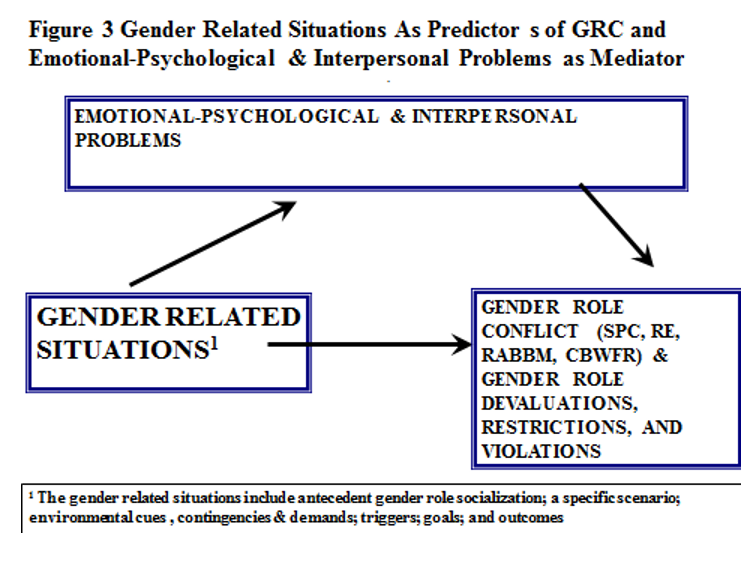 The research question for both Figure 3 is how and why do gender related situations relate to emotional-psychological and interpersonal problems with GRC as an outcome in men’s lives. In other words, is GRC an outcome of any negative situational contexts mediated by emotional-psychological problems? For Figure 4, the research question is how does GRC relate to negative gender related situations that cause men’s psychological problems. In other words, does GRC mediate situations in producing negative outcomes for men?
The research question for both Figure 3 is how and why do gender related situations relate to emotional-psychological and interpersonal problems with GRC as an outcome in men’s lives. In other words, is GRC an outcome of any negative situational contexts mediated by emotional-psychological problems? For Figure 4, the research question is how does GRC relate to negative gender related situations that cause men’s psychological problems. In other words, does GRC mediate situations in producing negative outcomes for men?
Both figures expand GRC’s role from just being a predictor of men’s problems to both a mediator and outcome of situational contingences that are gender related. This research paradigm suggests many new research questions on how GRC is affected by situational cues in men’s lives. For example, these new models promote situational GRC “from others” and “towards others” to be more completely conceptualized and researched .
First, like all research, studies need to be conceptualized using operationally defined concepts that have theoretical relevance to the psychology of men.
Figure 3 and 4 depict research paradigms where GRC is more than a predictor variable and situational contexts predict GRC as a dependent variable or GRC is a mediator of emotional/psychological problems. The critical question when creating research using Figure 3 and 4 is: What gender related situations cause GRC or how does GRC mediate negative outcomes for men in these situations??
The contextual and situational model in Figure 1 and the two research paradigms have utility when designing situational GRC studies. The model can help researchers theorize about GRC situations and the research paradigms can help create testable hypotheses whether GRC is an outcome variable or mediator variable. The models provide researchers with theoretical foundations to conceptualize their studies. Additional situational parameters need to be generated that expands understanding on how GRC is experienced and caused by others.
Figure 1 and the new GRC assumptions increase our understanding of how situational contexts relates to GRC, masculinity ideology, multicultural and diversity issues, and men’s overall psychological health. The correlational, moderation, and mediation studies reported earlier (See O’Neil, 2008, 2015; O’Neil; & Denke, 2016) provide an empirical foundation for expanded situational research. Unfortunately, the moderation and mediation studies reported do not test for situational dynamics. Predictive paradigms need to be expanded to test situational dynamics in real time for observed outcomes in GRC and assesses how men “do gender” in both experimental and real life settings by identifying triggers in the environment that explain how and when behaviors, attitudes, or internal conditions change or are expressed.
In summary, very little research exists that has examined the situational aspects of GRC because few research paradigms have been developed that can guide this important kind of research. The next steps are to generate more situational research paradigms that can explain the complexity of GRC in men’s lives. The critical questions are how do men learn restricted gender roles, experience GRC in specific situations, under what conditions, with what negative consequences and outcomes. (Addis et al., 2010; Jones & Heesacker, 2012).
Figure 3 and 4 depict research paradigms where GRC is more than a predictor variable and situational contexts predict GRC as a dependent variable or GRC is a mediator of emotional/psychological problems. The critical question when creating research using Figure 3 and 4 is: What gender related situations cause GRC or how does GRC mediate negative outcomes for men in these situations??
The research question for Figure 3 is how and why do gender related situations relate to emotional-psychological and interpersonal problems with GRC as an outcome in men’s lives. In other words, is GRC an outcome of any negative situational contexts mediated by emotional-psychological problems? For Figure 4, the research question is how does GRC relate to negative gender related situations that cause men’s psychological problems. In other words, does GRC mediate situations in producing negative outcomes for men?
Both figures expand GRC’s role from just being a predictor of men’s problems to both a mediator and outcome of situational contingences that are gender related. This research paradigm suggests many new research questions on how GRC is affected by situational cues in men’s lives. For example, these new models promote situational GRC “from others” and “towards others” to be more completely conceptualized and researched (See Table 4).
The contextual and situational model in Figure 1 and the three research paradigms have utility when designing situational GRC studies. The model can help researchers theorize about GRC situations and the research paradigms can help create testable hypotheses whether GRC is an outcome variable or mediator variable. The models provide researchers with theoretical foundations to conceptualize their studies. Additional situational parameters need to be generated that expands understanding on how GRC is experienced and caused by others.
Unfortunately, very few studies have examined the impact of GRC in a situation or how GRC is influenced by a situation. In order to investigate GRC in a micro-contextual sense, research studies were reviewed that examined GRC in relation to a controlled situation.
Future Gender Role Conflict (GRC) Hypotheses To Be Tested : Seven Contextual Domains and 18 Research Questions on men’s gender Role Conflict
This file enumerates seven contextual domains and 18 research questions on men’s gender role conflict.
This part of the web page guides future researchers in conceptualizing their research studies using a contextual perspective, and specific GRC research questions to do moderator, mediator, and situational studies.
The seven contextual domains of men’s GRC are based on the research reviewed in O’Neil (2008) and the previous research and theory in the psychology of men. The domains include: (a) Age, developmental stage, resolving developmental tasks, and gender role transitions; (b) Family interaction patterns, interpersonal situations, and peer relationships; (c) Masculinity ideology, norms, and conformity; (d) Psychological and physical health variables; (e) Men’s diversity - race, ethnicity, culture, class, religious, and sexual orientation as well as identity issues related to these categories; (f) Vulnerability variables related to violence, oppression, and abuse; and (g) Methods to help men resolve GRC through therapy and psychoeducational and preventive interventions. The seven domains provide an expanded theoretical basis for understanding the potential moderators and mediators of men’s GRC. To operationalize the seven contextual domains, 18 moderator and mediator research questions are enumerated in Table 1. These research questions can be pursued in the future researchers.
| Table 1.
Predictor, Moderator, and Mediator Hypotheses for Seven Contextual Domain for An Expanded GRC Research Paradigm |
| Domain 1: Age, Developmental Stage, and Gender Role Transition |
|
| Domain 2: Family Interaction Patterns , Interpersonal, and Peer Relationships |
|
| Domain 3: Masculine Ideology, Norms, Conformity, Discrepancy |
|
| Domain 4: Psychological and Health Variables |
|
| Domain 5: Men’s Diversity: Racial, Cultural, Class, and Sexual Orientation |
|
| Domain 6: Vulnerability Variables Related to Violence, Oppression, and Abuse |
|
| Domain 7: Methods To Help Men Resolve GRC: Therapy and Psychoeducational and Preventive Interventions |
|
